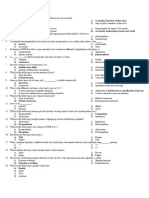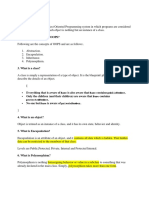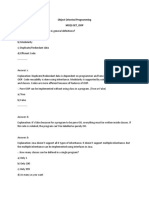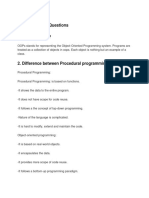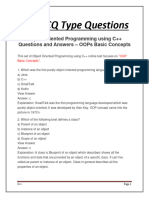1.Which of the following option best illustrates a friend class?
This class can access and manipulate all the private members of that class which
connects to a friend.
Friend class can only access and manipulate the protected data members of that
class that connects to a friend.
Friend class can't access any data member of another class but can use its methods
Friend class don't have any implementation
2. Which of following is shared structure of a set of similar objects
Encapsulation
A Class
Inheritance
None of Above
3. Which keyword is used to inherit a class or abstract class is?
extends
extend
implement
inherit
4. Which of the following is an abstract data type
Double
String
Int
Class
5.Which of the following is not related to OOPS?
Class and Object
Constructor and Destructor
Structure and Union
Inheritance and Polymorphism
6.Which Feature of OOP encourges the code reusability?
Polymorphism
Inheritance
�Abstraction
Encapsulation
7. Which of the following feature is also known as run-time binding or late binding
Dynamic typing
Dynamic loading
Dynamic binding
Data hiding
8.Which among the following is not a member of the class?
Virtual function
const function
Static function
Friend function
9. Which of the following class is known as the generic class?
Final class
Template class
Abstract class
Efficient code
10. Which of the following OOP concept binds the code and data together and keeps
them secure from the outside world?
Polymorphism
Inheritance
Abstraction
Encapsulation
11. Which member of the superclass is never accessible to the subclass?
Public member
Protected member
Private member
All of the mentioned
12. What is the size of a class?
Sum of the size of all inherited variables along with the variables of the same
�class
The size of the class is the largest size of the variable of the same class
Classes in the programming languages do not have any size
Sum of the size of all the variables within a class
13. Which class cannot create its instance?
Parent class
Nested class
Anonymous class
Abstract class
14. Which of the following statement of a program is not right?
class teacher{}; teacher s[5];
class teacher{}s;
class teacher{}; teacher s;
class teacher{}s[];
15. The object cannot be ?
passed by copy
passed as function
passed by value
passed by reference
16. Which of the following feature may be breaked if the user does not use the
classes in the code?
Object must be used violated
Only the encapsulation concept is violated
Inheritance cannot be implemented
Basically, all the features of OOPS get violated
17. The combination of abstraction of the data and code is viewed in
Inheritance
Object
Class
Interfaces
�18. The principle of abstraction.
is used to achieve OOPS.
is used to avoid duplication
Use abstraction at its minimum
is used to remove longer codes
19. A constructor
May consist of a return type
Doesn't consist of any return type
Has some return type
Of a derived class has a return type
20. If in case, in multiple inheritances, a class R would inherit the Class Q,
while Class Q would inherit the class P, then in which sequence would their
destructors be called in case we declare an object of Class R?
-R() then -P() then -Q()
-P() then -Q() then -R()
-Q() then -R() then -P()
-R() then -Q() then -P()
21. The memory that is allocated for any objects is
Cache
HDD
ROM
RAM
22. Hierarchical inheritance could be some subset of inheritance.
Multilevel
Single level
Multiple
Hybrid
23. What is the name of the feature in which we enforce the definitions of the
abstract function at the compile time?
Dynamic Polymorphism
Static Polymorphism
�Dynamic or Static Polymorphism according to need
Polymorphism
24. Which of following doesnot have a body?
An interface
A class
An Abstract Method
none of above
25. in oop, public,private and protected are
classes
Access modifiers
Interfaces
Method signature










